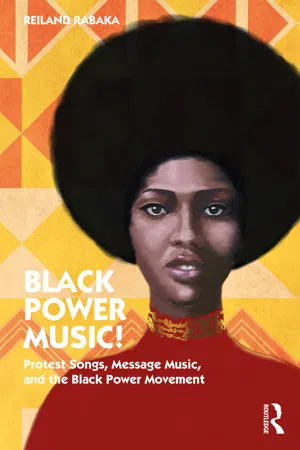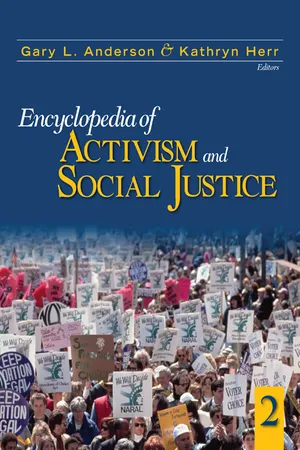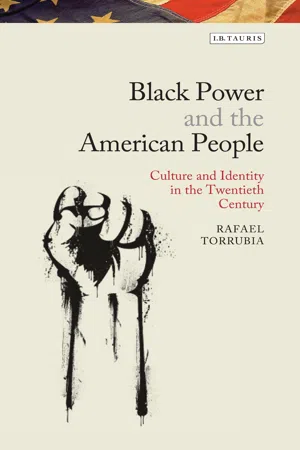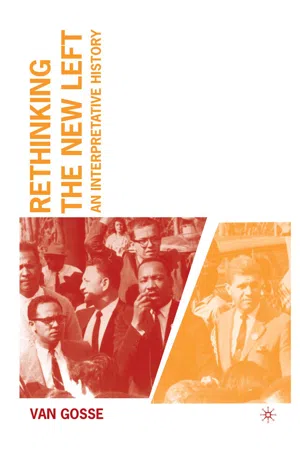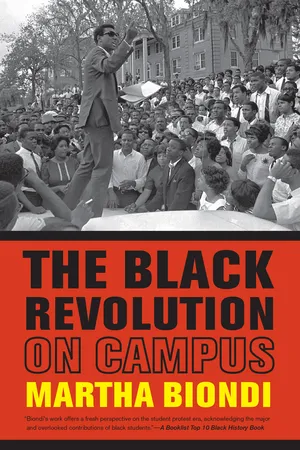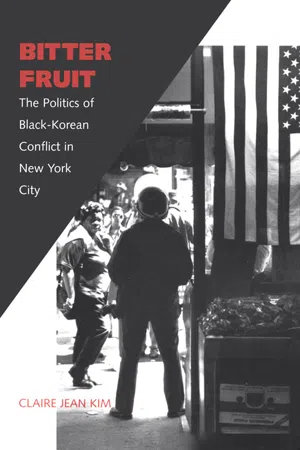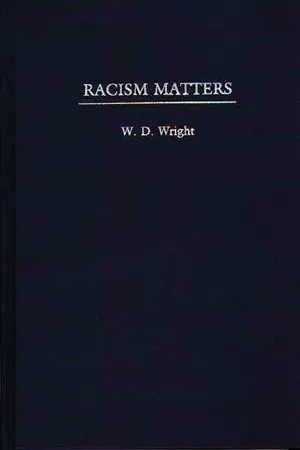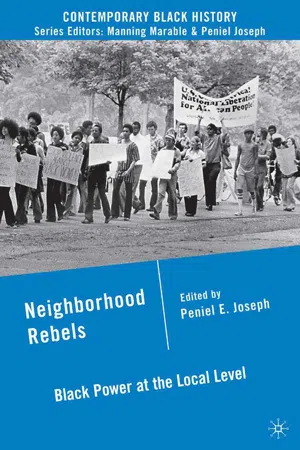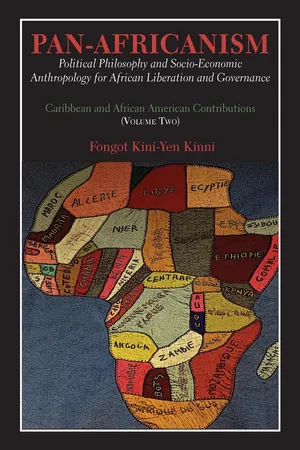History
Black Power Movement
The Black Power Movement was a social and political movement in the 1960s and 1970s that aimed to empower and liberate African Americans from systemic racism and oppression. It emphasized racial pride, self-determination, and community control, advocating for economic, political, and social equality. The movement also sought to challenge and transform the existing power structures in the United States.
Written by Perlego with AI-assistance
Related key terms
1 of 5
12 Key excerpts on "Black Power Movement"
- eBook - ePub
Black Power Music!
Protest Songs, Message Music, and the Black Power Movement
- Reiland Rabaka(Author)
- 2022(Publication Date)
- Routledge(Publisher)
38When one takes a long and hard look at the history of the Black Power Movement it is easy to see it as the logical evolution of the Civil Rights Movement’s efforts to attain liberty, dignity, and equality for Black folk in America. To be sure, Black Power militants greatly differed in semantics and tactics when compared with the Civil Rights moderates, but it must be borne in mind that in the final analysis the core concerns of the two movements were more congruous and complementary than conflictual and contradictory. Where the Civil Rights Movement was reformist and moderate, the Black Power Movement was radical and militant. In fact, the Black Power Movement ushered in a whole new age of unprecedented Black radicalism in the wake of the woes of the Civil Rights Movement. Its goals extended well beyond Civil Rights Movement conceptions of “integration” and “assimilation,” and it was not preoccupied with the reaffirmation of African Americans’ Civil Rights and the U.S. government’s public admission that it had a legal and ethical obligation to protect the constitutional rights of its Black citizens.39Black Power proponents daringly demanded access to the fundamental operative force in U.S. history, culture, society, and politics: power – physical and psychological, social and political, economic and educational, cultural and aesthetic. Following Malcolm X, they argued that they would gain power “by any means necessary.”40 Moreover, Malcolm X admonished Blacks to focus their energies and resources on improving their own conditions rather than exhorting Whites to allow them to integrate into mainstream America. He also preached Black self-defense, repeatedly reminding his audiences that Blacks have a constitutional right to retaliate against anti-Black racist violence.41 - eBook - ePub
Unbroken and Unbowed
A History of Black Protest in America
- Jimmie R. Hawkins(Author)
- 2022(Publication Date)
- Westminster John Knox Press(Publisher)
60—Stokely Carmichael in 1966The Black Power Movement signaled the closing out of the civil rights era. Black Power ideology demanded political equality partnered with economic self-sufficiency. SNCC chairman Stokely Carmichael popularized the slogan “Black Power” at a rally for the wounded James Meredith on June 16, 1966: “We been saying ‘freedom’ for six years. What we are going to start saying now is Black Power. We want Black Power! What do you want? Black Power!”61 Black power promoted business ownership and political candidacy. It embodied a love of self and the right to defend families and neighbors. No longer would an inherently racist white culture be the model for Black self-improvement. Adherents wore traditional African clothing and hairstyles and stressed the beauty of dark skin, rejecting skin lighteners and hair straighteners. Youth asserted, “Black is beautiful” as they danced to James Brown’s anthem “Say It Loud, I’m Black and I’m Proud!”The demand for Black power has existed as long as there has been Black protest. The primary goal of collective empowerment can only be achieved by dismantling the white power structure. It mirrored pan-Africanism’s goal of global unity for Black and African peoples. Early precursors of the pan-African movement date back to the nineteenth century in the defiant posture of Martin Delany, the fiery publisher of the Pittsburgh newspaper The Mystery (1843). He is affectionately referred to as “The Father of Black Nationalism” who coined the pan-African slogan “Africa for Africans.”62 William Monroe Trotter, one of the most fearless Black leaders of any century, founded the Boston Guardian newspaper with the following printed announcement: “We do for colored humanity what the world has conspired to deny us. We will not apologize, and we will not retreat—the Guardian makes itself responsible for our collective deliverance. None are free unless all are free.” According to today’s Guardian, he “invoked a black radical tradition rooted in eighteenth-century transatlantic slave rebellion and the militant abolition of African diasporic communities throughout the Americas.”63 - eBook - ePub
Black Power Encyclopedia
From "Black Is Beautiful" to Urban Uprisings [2 volumes]
- Akinyele Umoja, Karin L. Stanford, Jasmin A. Young, Akinyele Umoja, Karin L. Stanford, Jasmin A. Young(Authors)
- 2018(Publication Date)
- Greenwood(Publisher)
The Black Power Movement distinguished itself from the Civil Rights struggle for freedom. Civil Rights stressed desegregation and the inclusion of African Americans in the public institutions of mainstream society. Civil Rights leaders advocated the goal of a multiracial “beloved community” to be achieved through nonviolent activism, litigation, lobbying federal officials, and making moral appeals to white Americans, particularly northern liberals. Black Power emphasized Black political and economic control of Black institutions and communities, Black cultural identity, and abandoning the rhetoric of nonviolence.Certainly, Black nationalism, radical thought, and activism existed long before the Black Power Movement of the 1960s and 1970s. We argue that by 1965, beyond organizations and ideology, a dynamic movement emerged that became the dominant social force within the Black freedom struggle. What occurred in 1965–1966 that signaled the emergence of a new movement? According to historian and scholar activist John Bracey, by 1965 the term “Black Power” was popular among the Black masses in U.S. cities as a response to white supremacy. Bracey was a participant with other Black activists from Chicago, Detroit, and other midwestern cities who came together to form the Organization for Black Power (OBP) over a year before the popularization of the term by Carmichael and Ricks in Greenwood, Mississippi. Socialist Black worker James Boggs made the inaugural address to the OBP, citing the possibility of Black people to achieve political power in U.S. urban centers. Boggs encouraged his fellow activists to develop a movement to seize power, not to make appeals to the moral conscience of “America” as the integrationist Civil Rights Movement had done (Boggs, Ward, and Boggs 2011, 22, 166–168; Boggs 2012). The same year as this gathering of radical and Black nationalist activists, several other events occurred that led to the explosion of a national insurgent movement.In August 1965 a spontaneous uprising occurred in the Watts community of Los Angeles, California. An incident of political terror against Marquette Frye, a Black motorist, and his mother and brother resulted in six days of turmoil, 34 fatalities, and tens of millions of dollars in damages. Called a “riot” by the media and the power structure, the uprising was considered a Black rebellion and became a national symbol of resistance. While Civil Rights and moderate leaders’ urge for calm was rejected by the working and poor Black resistors of Watts, new militant spokespersons emerged to articulate the rage of the oppressed Black masses. Hakim Jamal’s Malcolm X Foundation and Maulana Karenga’s Us organization would be two of the groups that surfaced like a phoenix from the flames of the Watts Rebellion. Members of street organizations and neighborhood clubs (aka gangs) became radicalized from the resistance of Watts and helped form new groups such as the Community Alert Patrol and the Southern California chapter of the Black Panther Party (BPP). Watts was not only a local phenomenon in Los Angeles but also inspired Black radicals nationally. From Cuba, Black revolutionary in exile Robert Williams stated that Watts was “the beginning of a ferrous and devastating firestorm…. We are living in an age … of revolution” (Williams 2005). Spontaneous uprisings such as that in Watts became major occurrences in municipalities throughout the United States in the mid to late 1960s. These rebellions represented a mass sentiment away from nonviolence and the politics of respectability in the Black freedom struggle. Black Power activists such as Stokely Carmichael and H. Rap Brown became spokespersons to interpret and articulate the rage of the spontaneous resistance in the streets of American cities. - eBook - PDF
- Gary L. Anderson, Kathryn G. Herr, Gary Anderson, Kathryn G. Herr(Authors)
- 2007(Publication Date)
- SAGE Publications, Inc(Publisher)
The common ideo-logical threads running through all of these tendencies that defined Black Power were group solidarity, self-definition, self-determination, and self-defense. Ethnic or racial group solidarity included an emphasis on collective advancement rather than individual achievement and assimilation. Self-definition involved the rejection of imposed definitions; the redefining of group interests, goals, and objectives, as well as the means for advancing those interests and attaining those goals and objectives; and re-identification as Black or Afro-American rather than Negro, and as a people of color who constituted a global majority rather than an American minority. Self-determination ranged widely—from black people taking the lead in their own movement for liberation rather than letting others lead them, to community empowerment via building alternative institutions and taking control of existing ones, to plans for sovereignty and nation-building. Self-determination efforts included initia-tives to acquire political power, economic power, and educational and cultural autonomy and to end institu-tional racism and white domination in these spheres. Self-defense measures ranged from community patrols to spontaneous insurrections as responses to police brutality to more organized forms of armed struggle against white supremacist repression and aggression. Black Power as a Political Slogan The term Black Power entered the arena of public dis-course in June of 1966 and caused a storm of contro-versy and contention among civil rights activists and the general American public. Student Nonviolent Coordinating Committee (SNCC) activists Willie “Mukasa” Ricks and Stokely Carmichael (Kwame Ture) are credited with launching the term into the public sphere, though they did not coin it. The term had been used previously (as early as 1954) by the author Richard Wright, the militant activist Robert F. Williams, and Harlem congressman Adam Clayton Powell. - eBook - ePub
Black Power and the American People
Culture and Identity in the Twentieth Century
- Rafael Torrubia(Author)
- 2016(Publication Date)
- I.B. Tauris(Publisher)
In some respects, the growth of black militancy was a logical product of the civil rights movement’s efforts to achieve equality, dignity and freedom. This was not always immediately apparent, as a heavy layer of attitude, style and rhetoric cloaked the most salient similarities. Nevertheless the ultimate concerns of the two movements were consanguineous. There would have been no Black Power without civil rights and the 1960s movement was an incomplete precursor to the 1970s evolution of African-American consciousness.However, Black Power sought more than guarantees of legal equality and renewed governmental attention to constitutional rights. Militants wanted control of the defining force of American society – power, both actual and psychological, by ‘any means necessary’.80 In retrospect, these means came to encompass a bewildering array of cultural forms.Historians and the wider public still have problems grasping the scope and form of Black Power. Our collective historical memory is inevitably shaped by mass culture, and as Marita Sturken noted, the processes of representation which we choose, or are chosen for us, block out difficult to represent memories, replacing them with simpler ciphers, a commemorative shorthand.81 Our current difficulties in anatomising the complexity of the Black Power Movement lie in its mid-1960s origins. Despite the fact that as James Forman noted ‘by 1966 the problems of black people across the United States had become similar in all their fundamentals’, mainstream coverage suffered from confused and inconsistent framing, amid a quest for definable leaders and symbols amidst polarising rhetoric.82During the period, comprehensive enquiries which might have illuminated the movement’s cultural richness and diversity of thought were seldom attempted. Aspirational ideology and street-smart swagger were given roughly equal page space. The press rushed to cover race issues with little self-critique; neither routines nor approaches changed – the same sources were used and the same stories proliferated, using ‘values of conflict, proximity, prominence and the unusual occurrence’.83 Any attempt by contemporary social scientists to delineate the ideological variants of Black Power and locate common denominators would have been of immeasurable value, as would a more informed understanding of the diverse manner in which militants aspired to acquire power. This gap in source material is understandable. At the popular level the strategies and goals of 1960s campaigners were often entangled. Often methodologies were interpreted as goals, and vice versa. The international climate lent itself to fears of spontaneous anarchy. Most importantly, profound cultural differences between white and black America had created a distinct disjunction in interpretations of Black Power. Recognising this disjunction was seldom easy, as media interpreters were enmeshed in a network of ‘unquestioned racism [and] inferential assumptions . . . largely invisible to those who formulate the world in its terms.’84 - eBook - PDF
Rethinking the New Left
An Interpretative History
- V. Gosse(Author)
- 2016(Publication Date)
- Palgrave Macmillan(Publisher)
But focusing on the rage of young black people, the desire to separate from whites, and a few charismatic orators like Malcolm X and Carmichael ignores Black Power's deep roots, how it surged through African American communities, and the complexities of its competing strategies. Instead of a sudden eruption, Black Power grew slowly from ideas, organizations, personal networks, experiences, and tactics that were always under the radar of the national media, in cities and on campuses from New York to Los Angeles (with stopS in Philadelphia, Cleveland, Detroit, Chicago, and the Bay Area). It flared up like a brushfire after the southern Civil Rights movement reached its climax in 1963 - 1965, but the ideologies and institutions of Black Power had slowly accumulated over the preceding twenty years sillce World War II (see chapter 4). DEFIANCE: SLACK POWER ARRIVES , 1965- 1966 The events of 1965 provided a dramatic closufe for the Civil Rights movement, as well as fOf those black activists who were increasingly estranged by the leadership's insistence on nonviolence and cooperation with Cold War liberals-the array of white· led trade unions, churches, and foun· dations tied to the Democratic Party. Once the Voting Rights Act passed Congress overwhelmingly in August 1965, the legal and political basis of Jim Crow was visibly crumbling, and it would only be a few years, or even months, bef ore whi te segregationist politicians would begin appealing for HIICl POWU: "II KlllIU WITI!!. Ii UTIU?" I 113 black votes. Equally decisive for Black Power advocates was Malcolm X's assassination in February 1965. Many African Americans had rested their hopes and renewed pride upon this honest, resolute man whom the actor Ossie Davis eulogized as "our shining black prince." His killing by fellow Muslims, and the suspicion that government agencies abetted the murder. propelled many civil rights activists to take a new look at white America. - eBook - PDF
- Martha Biondi(Author)
- 2012(Publication Date)
- University of California Press(Publisher)
The word Black had negative connota-tions among most Americans, but Malcolm X, in particular, reversed its 26 | The Rise of Black Power on Campus meaning for a younger generation of African Americans, who ushered in a lasting change in group nomenclature and identity. By “thinking black” as Malcolm X urged, they “transformed blackness from an in-herited set of physical characteristics to a deliberate political and cul-tural stance.” 33 There were many attempts to establish regional and national student formations. In the spring of 1968, Black students from thirty-seven colleges in nineteen states met at Shaw University and formed the Congress for the Unity of Black Students. There were efforts to unify Black students in regional alliances over the next few years, notably in California, but also in Chicago, New York, and elsewhere. Most striking is the similarity of student grievances and reform goals, given this autonomous, local organizational structure. 34 The Black Power Movement elevated male leadership, reflecting the patriarchy of the larger society as well as the tactics and ideology of the late 1960s Black liberation movement. The reappraisal of nonvio-lence and embrace of more militant rhetoric increased the visibility of male leaders, as did the fallout from a report authored in 1965 by Daniel Patrick Moynihan of the U.S. Labor Department, which identified a rise in female-headed Black families as a worrisome economic indicator and unnatural social development. The Moynihan report would eventually help propel the rise of Black feminism, but at the time it dovetailed with the rise of Black nationalism, which had typically seen the cultivation of patriarchal gender roles as essential to race advancement. - eBook - PDF
- Stanley Rosen(Author)
- 2000(Publication Date)
- Yale University Press(Publisher)
to try to reconstitute the Black Power Movement, because we felt there... was a tremendous setback both politically and socially, as well as economically [for Black people]... We started having some meetings, trying to put together a movement toward bringing about the Black Power Movement... We felt that the quest for nationalism and Pan-Africanism was in sync with what the Black movements had started throughout the world and that had been crushed, or had been suppressed, and that was one of the reasons why we couldn't have any unity, we could not have a united front, so the best thing to put forward was demand for Black Power. This demand goes back into the last century... So we wanted to reconstitute that kind of movement because the movement went into a state of inertia and had not been really properly organized. It was almost dismantled between what the police were doing as far as rounding these people up in the 70s, forcing them into jail and forcing people out of the country, and the other ones being drugged. It was the kind of thing where you saw the movement almost disintegrate, although you saw how vital and vibrant it was in the '60s, so we wanted to go back to that. We wanted to get people starting to appreciate themselves, starting to have Black pride. That's why we wanted to start the Black Power Movement. As in the 19605, the Black Power frame's vagueness, its ability to sustain many different meanings simultaneously, helped activists to construct a united front, or what another movement leader called a house big enough for everybody to hang their coat. 23 Movement groups with crucial ideologi-cal differences could gather under the umbrella of Black Power, united in their determination to mobilize the Black community against oppression. So, too, could ordinary Black people. Whether they were committed Black na-tionalists or relatively apolitical sorts, they could all find common ground in their outrage at the Howard Beach killing. - eBook - PDF
- William D. Wright(Author)
- 1998(Publication Date)
- Praeger(Publisher)
Top Black leaders simply were not ready to deal with this kind of organized, bulk Black Power. They had fears of not being able to control it and direct it, and these were legitimate fears, because they themselves, with the exception of Martin Luther King, Jr., would not have been able to do either. Black Power broadened the struggle of Black people in America to include political and civil rights but also to include the cultural and social development of Blacks. The development of the Black community and its separate and independent power in America would give Blacks the ability to promote their social and cultural 89 The Origins and Legitimacy of Black Power interests in the country on a separate and integrated basis. Most top Black leaders could not get beyond political and civil rights and the social programs that could flow from them and which they conceived as part of civil rights, to ameliorate the condition of Black people and to improve life significantly for some. Black Power pointed Black leaders to the masses of Black people and to their power and devel- opment, for which top black leaders, with the exception of Martin Luther King, Jr., who came somewhat around to this position, were not ready. The confusion and vulnerabilities of top Black leaders in the 1960s and in the 1970s made them susceptible to the White denunciations of Black Power, their direct and indirect declarations that it was il- legitimate, and that it was illegitimate for Black people to develop and use group power in America. This was racist cant and racist fear. And this is something that Black people cannot let be their fear any- more; it can no longer be something that restrains or deters them. They need power in America, as any group of people ordinarily need power in any society. - eBook - PDF
Neighborhood Rebels
Black Power at the Local Level
- P. Joseph(Author)
- 2010(Publication Date)
- Palgrave Macmillan(Publisher)
Over time, as the Black Power Movement grew, local activists focused on empowerment, pride, and community development and protection. Regardless of the diversity in the Black Power Movement, however, militants shared the common aim of shifting agency into the hands of black people who would then assert their legitimate authority in, and in the interest of, their community. But, as local African Americans began to adopt the language of Black Power and promote its expression in community programs, the rising racial tension across the nation inspired fear among white city leaders about the potential for radicalism and violence, which lead to repression of activists through conspiracy and other trumped-up charges. This in turn sparked a “fight back” campaign— also part of a broader national movement—that in Louisville united Black Power militants, white leftists, and moderate whites who saw it as a way to take a stand against racism. 3 To some extent the Black Power philosophy did cause divisions within the local freedom struggle, as older African American leaders criticized the tactics and rhetoric of the rising generation. But, those divisions were gener- ational not racial. Instead, the reaction against Black Power and the repression that resulted provided the context for interracial organizing in the name of civil liberties and antiracism. The story of the Black Power era in Louisville, then, is a two-fold tale of the diverse ways that local people interpreted and acted on the philosophy and how the reaction to it provided the rallying point for the civil rights forces of the city. Just as Black Power had deep roots and a gradual pattern of development nationally, it grew in Louisville slowly and from multiple sources. There were early expressions of some of the ideas that would be called Black Power in the preaching of Louisville’s Nation of Islam (NOI) congregation, which existed by 1963 and which expressed both a desire “for the separation of Negroes and - eBook - PDF
We Ain’t What We Ought To Be
The Black Freedom Struggle from Emancipation to Obama
- Stephen Tuck(Author)
- 2011(Publication Date)
- Belknap Press(Publisher)
In 1979 one wig manufacturer told black consumers, “No price is too high to pay for your FREEDOM. This par-ticular FREEDOM is $6.72.” 78 As for soul music, cultural nationalists had been suspicious of white manipulation from the outset. (They pre-ferred free jazz, which sounded the global vision, global connections, and radical politics of many of its greatest artists. But free jazz lacked soul’s appeal to American consumers.) Over time, their suspicions increased. Black Panther Minister of Culture Emory Douglas complained, “You hear James Brown talking about Black and Proud, then you hear him on the radio saying ‘Why don’t you buy this beer?’” 79 If corporate leaders tried to co-opt black power protest, white neigh-borhood groups in the cities continued to oppose it. Ironically, they bor-rowed tactics from, and legitimized by, the Civil Rights Movement. Anti-busing leaders in Boston decided to “take a leaf out of Martin Luther King’s book,” holding sit-ins and even singing “We Shall Overcome.” In Philadelphia, a crowd of over a thousand Italian-Americans chanted “White Power!” to demand the closure of their local school, after a spate of fights between black and white children. 80 The shelf life of the Black Power Movement—roughly six years—was similar to that of the Civil Rights Movement of the early 1960s. The leg-acy of Black Power would live on just as long as that of the Civil Rights movement, too. Many local groups continued. The celebration of African American culture—such as the Kwanzaa holiday—continued into the twenty-first century. Bobby Rush, co-founder of the Chicago Panthers, would become a long-serving member of Congress. In 2000 he would swat away the challenge of a young, aspiring politician called Barack Obama. Thus, the fall of Black Power was not the end of black power, just a fall from its dominating position in national discourse. But then again, the rise of Black Power did not mean the end of civil rights demon-strations in the South. - eBook - PDF
- Kini-Yen Kinni(Author)
- 2015(Publication Date)
- Langaa RPCIG(Publisher)
An eloquent document of the civil rights movement that remains a work of profound social relevance 25 years after it was first published.” Carmichael’s Black Power Philosophy was rejected by members of the National Association for the Advancement of Coloured People – NAACP, and the Southern Christian Leadership Conference – SCLC who accused him of Black Racism in reverse. Their criticism levied against him and http://www.google.com/review/list/ (10/03/2013) Black Power was that: “Black Power was responsible for “highlighting racial divisions,” “eschewing coalitions with whites,” attempting “to kick whites out of the civil rights movement,” and being “anti-white, defeatist, and bitterly rejecting the civil rights movement’s traditional goal of integration”…” But Carmichael and Hamilton were of the opinion that before coalitions are made, they must emanate from a platform of equality which did not exist between the Black community and the Whites who were seen as more or less patronising the elitist Blacks. The call for all Black people to unite into a common platform was to enable them as a people set stable launching sustainable counter-base apart because of their race and colour to build a stronger and common voice to build up a social capital capable of investing in the negotiations of their contiguities and needs in a White dominated society where the play-ground was not even, open and free for initiators of social change. That is the reason why Carmichael and Hamilton talked elaborately on “The Myths of Coalition” in their work, while insisting that: “There is strongly held view in this society that the best - indeed, perhaps the only – way for black people to win their political and economic rights is by forming coalitions with liberal labor, church and other kinds of sympathetic organizations or forces, 122 including the “liberal left” wing of the Democratic Party.
Index pages curate the most relevant extracts from our library of academic textbooks. They’ve been created using an in-house natural language model (NLM), each adding context and meaning to key research topics.
